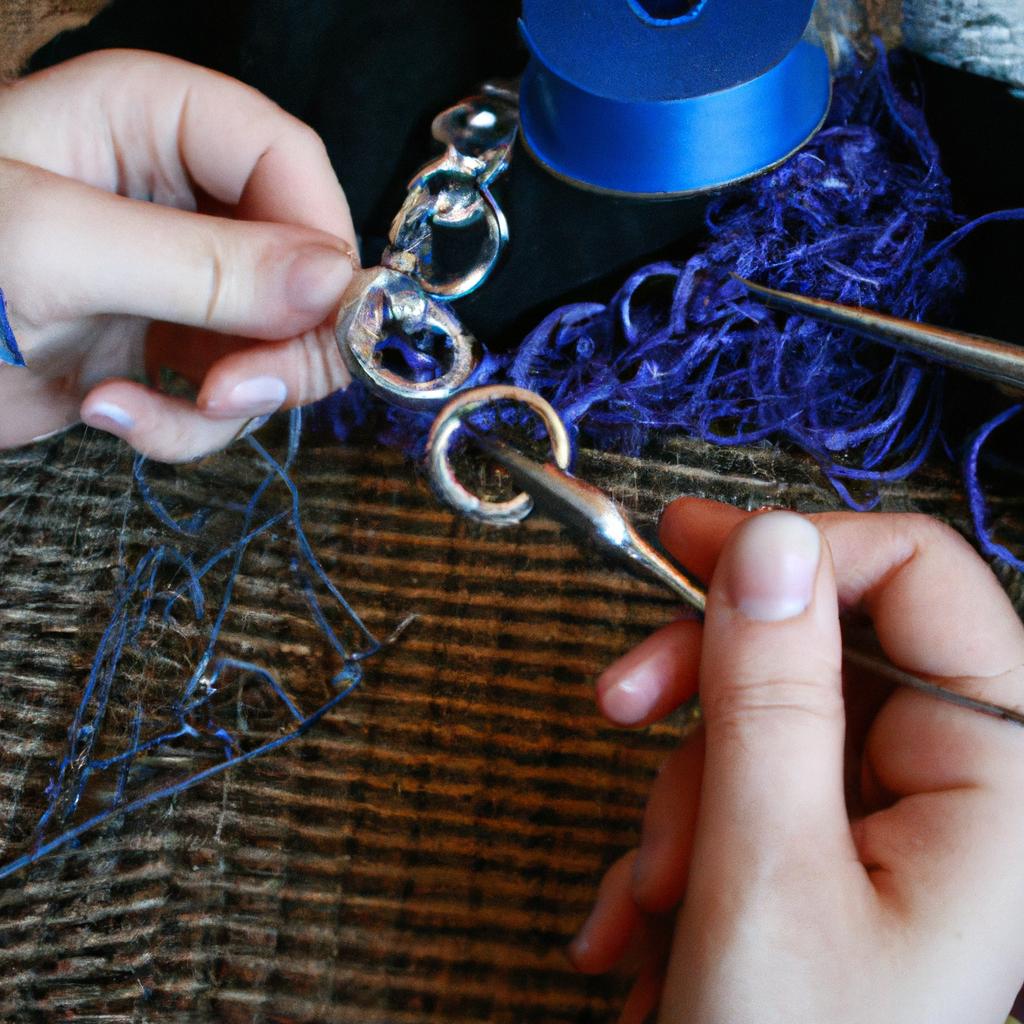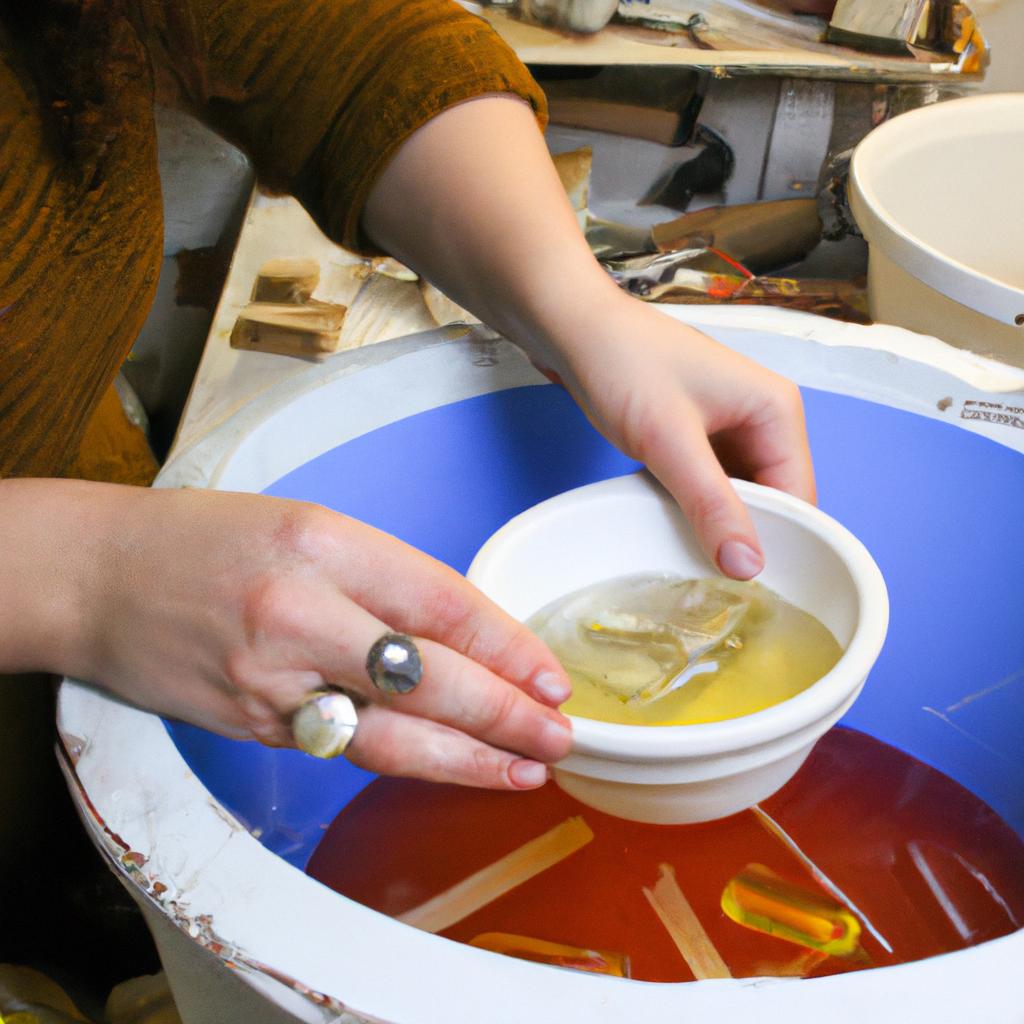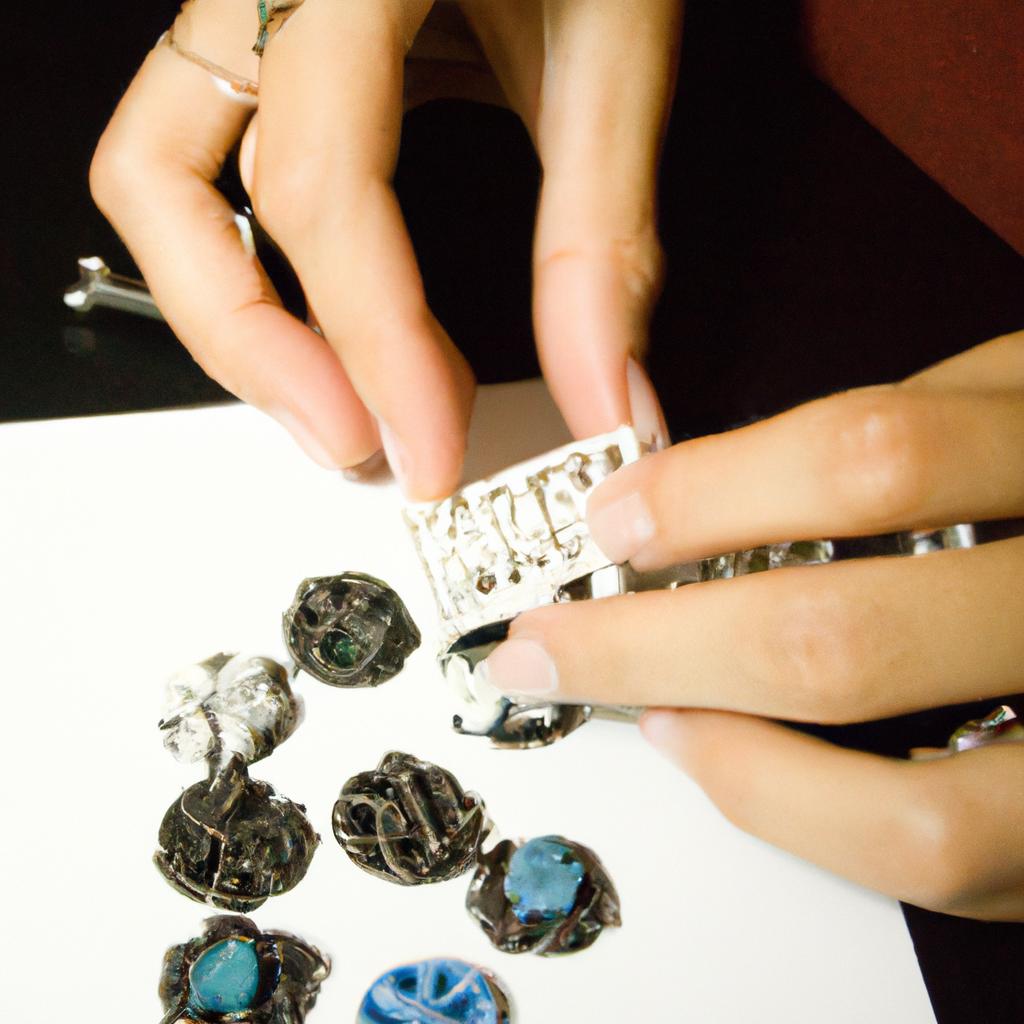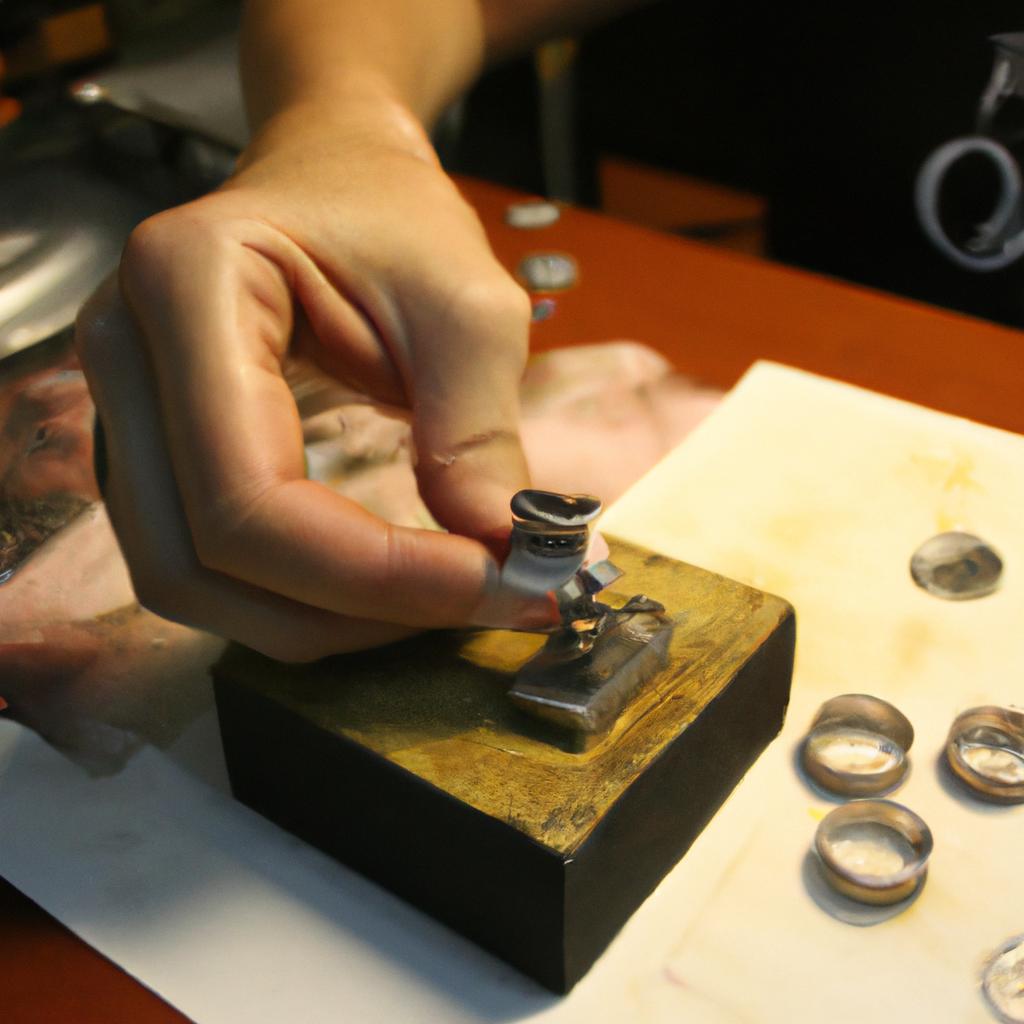Beadwork in jewelry making is a fascinating and intricate art form that has been practiced for centuries across various cultures. The meticulous craft of incorporating beads into jewelry not only adds visual appeal but also carries significant cultural and symbolic meanings. For instance, imagine a delicate necklace adorned with vibrant gemstone beads meticulously woven together by hand to create an exquisite piece of wearable art. This example illustrates the captivating nature of beadwork and its ability to transform simple materials into stunning pieces that reflect individuality and craftsmanship.
This informative guide aims to explore the rich history, techniques, and creative possibilities of beadwork in jewelry making. By delving into the origins of this ancient art form, we can gain a deeper understanding of how it has evolved over time and influenced contemporary designs. Additionally, we will examine various beading techniques such as stringing, weaving, embroidery, and wirework, highlighting their unique characteristics and applications in creating diverse styles of jewelry. Furthermore, this article will discuss the materials commonly used in beadwork, including different types of beads and findings available to artists today. Whether you are a novice or experienced jeweler seeking inspiration or knowledge about beadwork, this comprehensive guide intends to provide valuable insights into this captivating world of creativity and craftsmanship.
History of Beadwork
Beadwork has a rich and fascinating history, spanning across various cultures and time periods. One compelling example is the use of beadwork by Native American tribes in their traditional regalia. For instance, the Lakota Sioux tribe utilizes intricate beadwork to adorn ceremonial garments and accessories, such as moccasins and headdresses. This case study highlights the significance of beadwork as an essential cultural practice that preserves traditions and tells stories.
To fully appreciate the artistry behind beadwork, it is crucial to understand its historical context. Beads have been utilized for centuries as decorative elements, functional objects, or symbols with spiritual meanings. The precise origins of beadwork remain unclear; however, archaeological evidence suggests that beads made from shells, stones, bones, and seeds were used thousands of years ago. Over time, different materials and techniques emerged, allowing for more intricate designs and patterns.
The emotional impact of beadwork cannot be overlooked. It evokes a sense of awe through its meticulous craftsmanship and attention to detail. Here are four reasons why beadwork continues to captivate individuals:
- Versatility: Beads come in a wide range of colors, shapes, sizes, and textures, offering endless possibilities for artistic expression.
- Connection to culture: Many indigenous communities consider beadwork an integral part of their heritage, passing down skills and knowledge from one generation to another.
- Therapeutic benefits: Engaging in beadwork can provide relaxation and stress relief while promoting focus and mindfulness.
- Symbolism: Each type of bead carries unique symbolism within specific cultures or contexts.
Furthermore, exploring the world of beadwork involves delving into its diverse array of beads used throughout history. These include glass beads (such as seed beads), gemstone beads (like turquoise or amethyst), metal beads (such as silver or gold-plated), wood beads (derived from trees like rosewood or sandalwood), ceramic beads, and many more. The types of beads used vary depending on cultural traditions, personal preferences, and the desired aesthetic outcome.
Understanding the history behind beadwork sets the stage for a deeper appreciation of its significance in various cultures worldwide. In the subsequent section about “Types of Beads Used in Beadwork,” we will explore different materials that have been utilized to create exquisite pieces throughout history.
Emotional Bullet Points:
- Diverse colors, shapes, and textures ignite creativity and imagination.
- Connection to ancestral roots fosters a sense of identity and belonging.
- Engaging in beadwork can provide solace during challenging times.
- Each bead carries stories, beliefs, or aspirations within its delicate form.
| Types of Beads | Material | Symbolism | Cultural Significance |
|---|---|---|---|
| Glass | Seed beads | Unity | Widely used globally |
| Gemstone | Turquoise | Protection | Sacred stone among… |
| Metal | Silver-plated | Wealth | Commonly found in… |
| Wood | Rosewood | Grounding | Derived from trees… |
In conclusion, beadwork’s historical roots reveal its enduring appeal as an art form. By examining specific examples like Native American tribes’ use of intricate designs, we gain insight into how beadwork connects with culture while appreciating its emotional impact. Understanding this background allows us to delve further into exploring the diverse range of beads employed throughout time. Consequently, our journey leads us to examine the different types of beads used in beadwork without skipping a beat.
Types of Beads Used in Beadwork
Beadwork in Jewelry Making: An Informative Guide
History of Beadwork (Continued)
In the previous section, we explored the fascinating history of beadwork and its cultural significance. Now, let us delve into the various types of beads used in this intricate craft.
To truly appreciate the artistry behind beadwork, it is essential to understand the diverse range of beads utilized by artisans worldwide. From ancient civilizations to modern-day designers, countless varieties have been employed to create stunning jewelry pieces. One example that highlights this diversity is the use of seed beads. These small, uniformly shaped beads are often used for detailed designs due to their size and versatility.
When examining the types of beads used in beadwork, several categories emerge:
-
Natural Materials:
- Shells: Known for their iridescent luster and unique textures.
- Gemstones: Offer a wide spectrum of colors and patterns.
- Bone or Ivory: Historically popular materials due to their durability.
-
Glass Beads:
- Lampwork Beads: Handmade glass beads crafted using a torch flame.
- Seed Beads: Tiny glass spheres with uniform shapes and sizes.
- Czech Glass Beads: Renowned for their vibrant colors and high-quality craftsmanship.
-
Metal Beads:
- Sterling Silver Beads: Add elegance and refinement to any design.
- Gold-Filled Beads: Provide a touch of luxury without breaking the bank.
- Brass or Copper Beads: Embrace an antique aesthetic while maintaining affordability.
-
Synthetic or Acrylic Beads:
- Plastic Beads: Lightweight options available in various shapes and finishes.
- Resin Beads: Mimic natural materials such as wood or stone but offer more versatility.
- Lucite Beads: Transparent acrylic beads known for their vibrant hues.
As shown by this diverse array of bead types, the possibilities for creative expression in jewelry making are endless. By carefully selecting and combining different beads, artisans can achieve unique designs that captivate the eye.
Whether you are a beginner or an experienced artisan, understanding these fundamental aspects is crucial for successful jewelry creation. So let us now dive into the world of tools and materials for beadwork.
Tools and Materials for Beadwork
In the previous section, we explored the various types of beads commonly used in beadwork. Now, let’s delve into the essential tools and materials required for this intricate craft.
Before embarking on a beadwork project, it is crucial to have a well-stocked toolbox. Here are some must-have tools:
- Needle-nose pliers: These slender pliers with pointed tips are ideal for gripping and manipulating small components.
- Wire cutters: Essential for trimming beading wire or thread without fraying or damaging the material.
- Bead mats: A soft surface that prevents beads from rolling away while you work, ensuring they stay organized and easily accessible.
- Beading needles: Thinner than regular sewing needles, these specialized needles allow easy passage through tiny bead holes.
Now that we’ve covered the necessary tools, let’s discuss the materials needed for beadwork. It goes without saying that beads themselves are fundamental to any beadwork project. You can find them in an endless variety of shapes, sizes, colors, and materials such as glass, crystal, gemstones, wood, plastic, metal, and more.
To give you an idea of how diverse this craft can be, consider this hypothetical scenario: Imagine creating a mesmerizing necklace using vibrant glass seed beads meticulously woven together in a peyote stitch pattern. The end result would be a stunning piece of wearable art displaying intricate details and breathtaking color combinations.
Let’s now explore four key emotions often associated with beadwork:
- Creativity: Beadwork allows individuals to express their artistic flair by designing unique patterns and arrangements.
- Relaxation: Engaging in beadwork can provide a calming effect on the mind as one focuses on each meticulous step.
- Achievement: Completing a complex beadwork project brings satisfaction and pride in mastering new techniques.
- Connection: Participating in group beading activities fosters a sense of community and enables social interaction.
Additionally, here is a table summarizing the various types of beads commonly used in beadwork:
| Bead Type | Description | Example Use |
|---|---|---|
| Seed beads | Small, uniformly shaped beads | Embroidery, weaving |
| Gemstone | Natural stones with unique colors and patterns | Jewelry making |
| Czech glass | High-quality glass beads from the Czech Republic | Bracelets, earrings |
| Swarovski | Precision-cut crystals known for their brilliance | Statement jewelry, accessories |
With an understanding of the tools needed and a glimpse into the emotional aspects associated with beadwork, we can now move on to exploring techniques for creating intricate designs using these beautiful materials.
Techniques for Creating Beadwork
Building upon a solid foundation of knowledge about beadwork tools and materials, we now delve into the various techniques that are essential for creating stunning beadwork. Understanding these techniques will provide you with the necessary skills to bring your creative visions to life.
When it comes to beadwork, one popular technique is known as stringing. This involves threading beads onto a flexible material such as wire or thread to create beautiful jewelry pieces. For instance, imagine designing an elegant necklace using delicate seed beads in shades of blue and silver. By carefully stringing each bead onto a sturdy yet pliable wire, you can turn this vision into reality.
Another technique widely used in beadwork is weaving. This method involves interlacing individual beads together using needle and thread, resulting in intricate patterns and designs. Consider a scenario where you aim to craft a beaded bracelet featuring geometric shapes. Through weaving different colored beads in specific arrangements using peyote stitch or brick stitch, you can achieve a visually captivating piece that showcases both skillful craftsmanship and artistic flair.
To further enhance your understanding of the versatility of beadwork techniques, here are some notable benefits:
- Allows for customization and personalization
- Offers endless possibilities for creativity
- Provides opportunities for self-expression
- Can be utilized across various types of jewelry making projects
Let’s take a moment to explore these benefits through the following table:
| Benefits of Beadwork Techniques |
|---|
| Enables unique design options |
| Encourages exploration |
| Fosters self-confidence |
| Cultivates mindfulness |
By mastering the art of beadwork techniques, you unlock boundless potential for self-expression while cultivating mindfulness through engaging in meditative practices involved in crafting intricate designs. These skills will serve as valuable assets as we move forward into exploring tips for designing beadwork patterns—where imagination truly takes flight.
With a solid foundation in beadwork techniques, you are now ready to embark on an exciting journey—learning valuable tips and tricks that will empower you to create captivating and unique patterns for your beadwork projects.
Tips for Designing Beadwork Patterns
Building upon the foundation of understanding beadwork, this section will explore various techniques that can be employed to create intricate and captivating jewelry pieces. Let’s delve into some key techniques used in beadwork.
Techniques for Creating Beadwork:
-
Stringing: One popular technique is stringing beads onto a thread or wire to form a continuous strand. This method allows for versatility in design as different types, sizes, shapes, and colors of beads can be combined to create unique patterns. For instance, imagine an elegant necklace created by skillfully stringing together delicate seed beads with larger focal beads interspersed throughout.
-
Weaving: Weaving involves interlacing individual beads using threads or cords to create complex designs. A case study illustrating this technique would be weaving tiny glass seed beads together on a loom to craft a mesmerizing bracelet with geometric patterns. The artistry lies in carefully aligning each bead within the pattern to achieve symmetry and balance.
-
Embroidery: Similar to traditional fabric embroidery, bead embroidery incorporates small beads stitched onto a fabric base using needle and thread. This technique offers endless possibilities for embellishing clothing, accessories, or even home decor items such as pillows or wall hangings. Imagine adorning a plain clutch bag with shimmering sequins and intricately embroidered seed beads to transform it into a statement piece.
- Creativity unleashed through limitless combinations of color schemes.
- Satisfying sense of accomplishment when completing intricate beadwork projects.
- Relaxation and stress relief experienced during the rhythmic process of threading each bead.
- Pride in wearing or gifting handmade jewelry pieces that reflect personal style and craftsmanship.
Table (3 columns x 4 rows):
| Technique | Description | Example |
|---|---|---|
| Stringing | Beads are threaded onto a string or wire to create continuous strands. | A multi-strand bracelet with different shapes and sizes of beads. |
| Weaving | Interlacing individual beads using threads or cords to form intricate patterns. | A beaded tapestry depicting a scenic landscape created through weaving. |
| Embroidery | Small beads stitched onto fabric using needle and thread for decorative purposes. | An embroidered evening gown adorned with seed beads and sequins. |
Armed with an understanding of various beadwork techniques, the next section will focus on valuable tips for designing beadwork patterns that will elevate your creations to new heights.
Popular Beadwork Projects
Designing Beadwork Patterns: A Creative Journey
In the previous section, we explored various tips to enhance your beadwork patterns. Now, let us delve deeper into the creative process of designing these intricate patterns that captivate both the maker and the beholder.
Imagine you are creating a beaded necklace inspired by nature’s vibrant colors. The first step in this creative journey is to gather inspiration from botanical gardens or picturesque landscapes. Let’s consider an example where you draw inspiration from blooming cherry blossoms. These delicate flowers feature soft pink petals with hints of white, symbolizing purity and ephemeral beauty. By observing their intricate details and capturing their essence through beads, you can create a pattern that encapsulates the spirit of these enchanting blooms.
To assist you further on this creative endeavor, here are some guidelines for designing beadwork patterns:
-
Select a focal point: Choose one element within your design that will catch the viewer’s attention immediately. It could be a unique centerpiece or an arrangement of beads in contrasting colors.
-
Experiment with color combinations: Play around with different hues to evoke specific emotions or create harmonious contrasts. Consider using analogous colors (such as shades of blue and green) to convey tranquility or complementary colors (like purple and yellow) to signify vibrancy and energy.
-
Incorporate varying textures: Introduce diversity in your pattern by combining different types of beads – smooth glass beads, faceted crystals, or metallic accents – to add visual interest and tactile appeal.
-
Balance symmetry and asymmetry: Strive for equilibrium when arranging your beads; symmetrical designs often exude elegance and formality while asymmetrical layouts offer a more contemporary feel.
Now, let us visualize these concepts through an emotional lens:
-
Bullet Point List:
- Immerse yourself in the soothing atmosphere of nature-inspired jewelry.
- Experience joy as you bring together disparate elements into a harmonious design.
- Feel a sense of accomplishment as you create patterns that reflect your unique artistic vision.
- Rediscover the beauty in imperfection and asymmetry, embracing the unexpected.
-
Table:
| Focal Point | Color Combinations | Textures |
|---|---|---|
| Unique centerpiece or arrangement | Analogous: blue and green | Smooth glass beads |
| Complementary: purple and yellow | Faceted crystals |
In summary, designing beadwork patterns is an exciting endeavor where creativity intertwines with technical skills. By drawing inspiration from nature, experimenting with colors and textures, and balancing symmetry and asymmetry, you can craft captivating designs that evoke emotions within both yourself and those who admire your creations. Embark on this creative journey to discover the endless possibilities that beadwork offers.
 Shanes Jewelry
Shanes Jewelry



